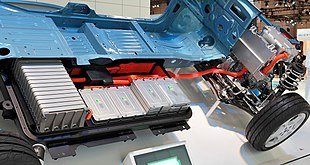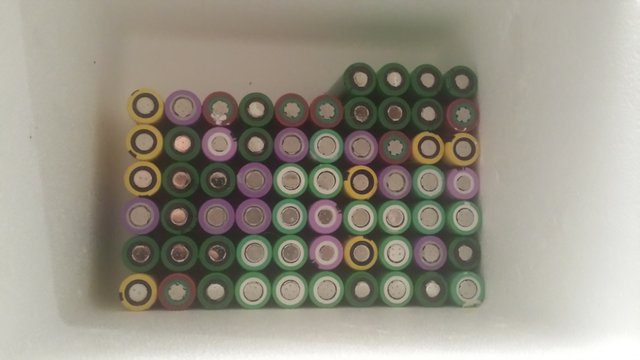Electric Vehicle batteries are beginning to show up in off grid fixed power systems.
Batteries from wreaked or scrapped vehicles are finding their way into alternate power systems for off grid use. Some systems can be purchased from a salvage yard that are a fraction of the cost of lead acid battery system.
Image from article, Nissan Leaf cutaway showing part of the battery in 2009
https://en.wikipedia.org/wiki/Electric_vehicle_battery
So look at your local automotive salvage yards, for unlucky Hybrid cars. The battery systems from these cars can be large enough to power your entire house, from a single pack!
Here is a listing of models with onboard batteries by make, and battery capacity:
https://en.wikipedia.org/wiki/Electric_vehicle_battery
I was surprised at the length of this list, I thought there were only a few electric vehicle models out there. here are the full electric models:
Addax MT: 10-15 kWh
Audi e-tron: 95 kWh
BMW i3: 22–33 kWh
BYD e6: 60–82 kWh
Chevrolet Bolt / Opel Ampera-e: 60 kWh
Citroen C-Zero / Peugeot iOn (i.MIEV): 16 kWh (2010) / 14,5 kWh (2013-)
Fiat 500e: 24 kWh
Ford Focus Electric: 23 kWh (2012), 33.5 kWh (2018)
Honda Clarity (2018): 25.5 kWh
Hyundai Kona Electric: 39.2–64 kWh
Hyundai Ioniq Electric: 28 kWh
Kia Soul EV: 27 kWh
Kia Niro EV: 39.2–64 kWh
Jaguar I-Pace: 90 kWh
Nissan Leaf I: 24–30 kWh
Nissan Leaf II: 24-60 kWh
Mercedes-Benz EQ C: 80 kWh
Mitsubishi i-MIEV: 16 kWh
Renault Fluence Z.E.: 22 kWh
Renault Twizy: 6 kWh
Renault Zoe: 22 kWh (2012), 41 kWh (2016)
Smart electric drive II: 16.5 kWh
Smart electric drive III: 17.6 kWh
Tesla Model S: 60–100 kWh
Tesla Model X: 60–100 kWh
Tesla Model 3: 50–70 kWh
Tesla Model Y: 50–70 kWh
Toyota RAV4 EV: 27.4 kWh (1997), 41.8 kWh (2012)
Volkswagen e-Golf Mk7: 24–36 kWh
Volkswagen e-Up!: 18.7 kWh
Rimac C_Two: 120 kWh
There is an equally long list in Hybrids, usually with a slightly smaller battery pack, because they have an onboard gasoline engine too.
I am moving off grid myself, and I had decided that a battery with 24,000 watts (24 KW) is large enough to run my house. SO you can see that some of these packs are large enough to do that job. Eventually, I would like to see about 50 KW on my battery bank.
I will begin with 2500 watts of solar panels, and 1500 watts of wind power. With my average sun here I can expect 20,000 watts a day (20KW) from the panels; and with my average wind velocity locally, I can expect about 12,000 watts of wind power So while generating 32 KW per day, I will be able to fully charge my batteries daily, plus run the house on the excess. A reasonable load on my charging sources will be 14 KW for AC / Heat Leaving me 18 KW of battery charge. another 3KW will be needed for refrigeration and freezer power; leaving 15 KW excess for battery charge. If the sun is blocked by clouds, the average wind increases, to where the wind generator will be making 24 KW, which will handle the full house load plus a 4kw charge on the batteries.
The single largest advantage of harvesting vehicle batteries from wreaked cars, in on fixed service, LiIon batteries should last six times as long as lead acid batteries. These are 30 + year battery packs, so they are worth a little trouble. I have an off grid friend in Florida, who bought one of the smaller Tesla batteries almost ten years ago, and is still happy with the system. Some of the battery packs can be purchased for $700; so at that cost, electric power storage would only run $70 per year in a decade, or $24 per Year over the life of the battery system! $2 a Month is not very expensive electric power storage costs....
So there are ways to save cash while moving off grid, so get creative. Any good system will have several different charging sources, to bridge any input power gaps.

That's a great idea. I have a test setup in my back barn with my solar setup. Right now I'm running old cell tower batteries (AGM 160ah x 8). Was thinking of using old fork lift batteries but now you have me thinking. We have a ton of the Chevy Volts in my area. Should be able to find a wrecked one. Thanks for the heads up!
Always good to find another person infected with off grid fever, ROFLOL! Glad I could help.
I am also recovering cell from old lap top packs for recycle prices, I have 8KW so far, and they sell Battery Management Systems (BMS) for a 24 volt stack on Ebay for $6. So I am going to build part of my power storage from the cells that test good.
Here is my latest batch of salvaged good cells:

:)>Apply to https://steemit.com/ecotrain/@ecotrain/the-real-life-repurposing-abundance-waste-challenge-50-steem-in-prizes-ecotrain-question-of-the-week-part-2-4
Interesting, I will think about it.
:)>That's awesome! I just switched over to 24v from 12v. What kind of wind power are you running? I've been looking into it for a while but reviews aren't great. I'm surrounded by open farm fields and get some decent wind.
Not running yet, sorry. I am an Engineer, working from the specs, and reviews.
Most bad reviews are because people do not understand that wind power is wind dependent. This is a 1700 watt rated wind generator, but with my average wind speed at the new land, it will make about 500 watts. People trash talk a wind generator, because they expect 1700 watts...all the time. These guys up in Mo understand high performance wind generators, and make their own generators to avoid cogging problems. Here is the one I will buy:
https://www.ebay.com/itm/Missouri-Rebel-Freedom-24-volt-1700-watts-max-5-blade-wind-turbine-generator/291189976502?ssPageName=STRK%3AMEBIDX%3AIT&_trksid=p2060353.m1438.l2649
On a wind generator, there must be a brake, or a dump load to use if the batteries are fully charged. Otherwise, the unloaded wind generator can over volt, and damage the generator and charger. This is true of all wind generators, but it is not a large problem. Just be sure that the dump load will absorb the full output for high wind conditions.
24 Volts is the best mix of wire size battery power, and cost of electronics. You have made a good choice. I plan to run my LED lighting, and ceiling fans directly from the batteries. I will run 24 volt DC to every room, using the old AC ducts as a wiring race. I am building the lights, and their dimmers from components.
The inverter power wall will feed to existing breaker panel, and will be battery fed from under the house, in the crawl space. Repairing and insulating the house right now, I will be posting as I go.
Here is a way to reuse your old 12 volt power sources on a 24 volt battery.
https://www.ebay.com/itm/332302608742
Yes those electric car battery packs will be a great source of cheap house batteries.
Posted using Partiko Android
They are becoming easier to find, and the cost is dropping all the time! I have to find and grab one soon, LOL.
:)>